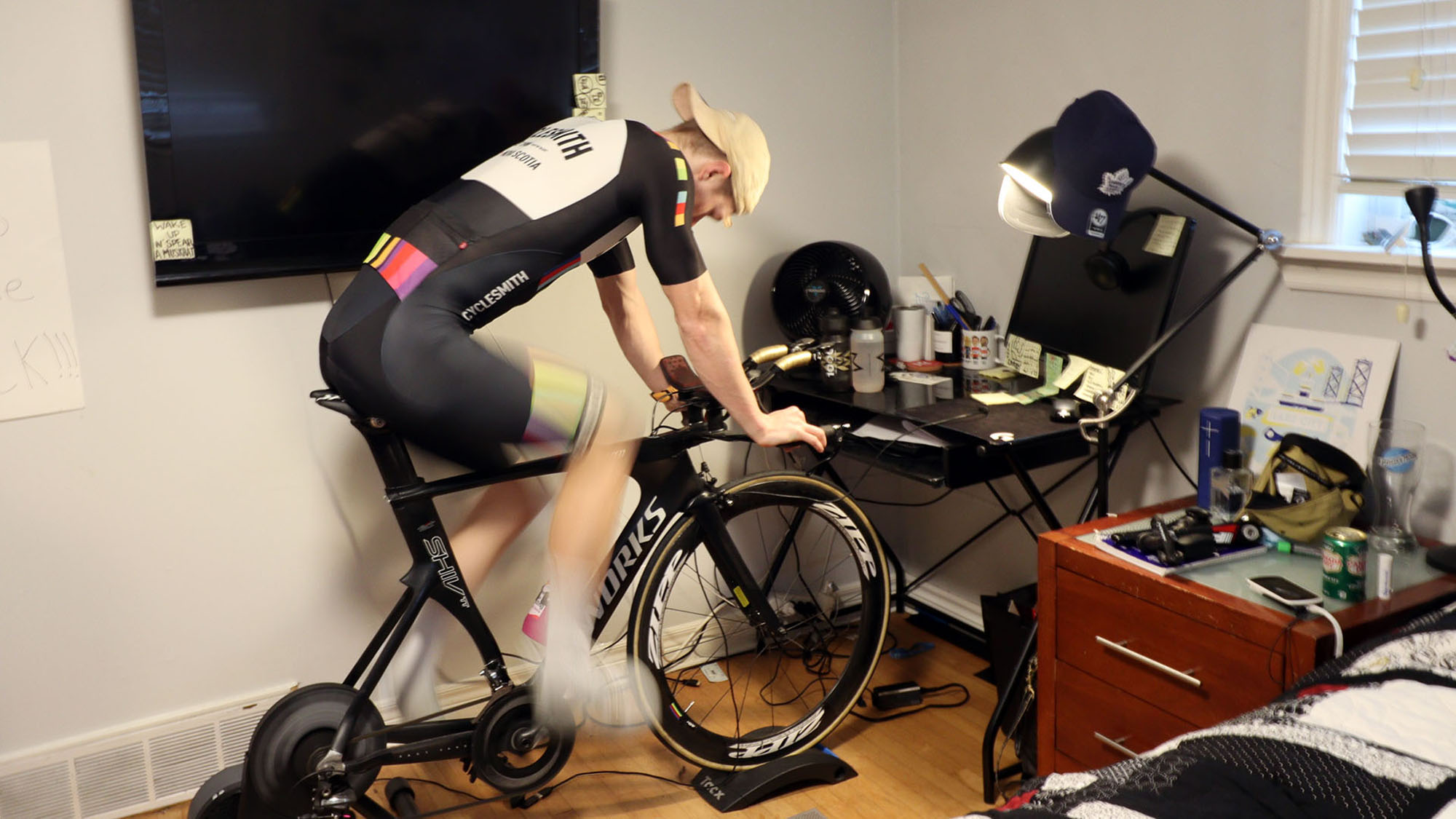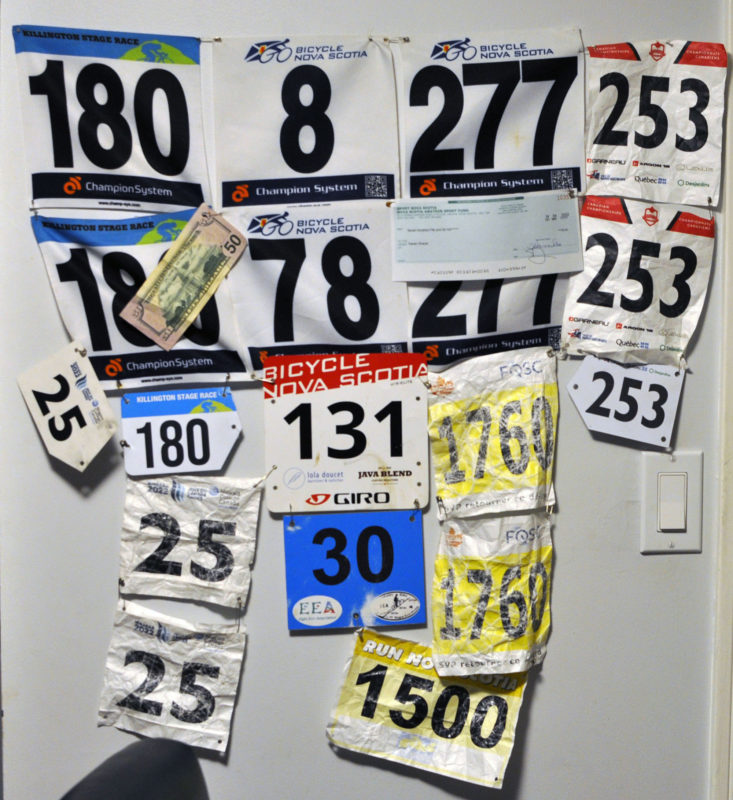Race to the bottom?

caption
Kieran Sharpe training in his house in Dartmouth.Competitive cycling needs a better grip on mental health. It might look to hockey.
One day in 2021, standing in the bathroom of his house in Dartmouth, Kieran Sharpe took a hard look in the mirror and asked himself, “who is this looking back at me? And is this who I want to be?”
He knew something needed to change.
Sharpe had lost 10 pounds in a month in an effort to improve his power to weight ratio. After some less than ideal results on a performance test, he had restricted his eating under the pressure to perform. Six feet tall, he weighed only 144 pounds, and his cheeks were hollowed out in a way that was scary. It was a constant struggle between being a good cyclist and not looking like a skeleton.
“I just was sick and tired of not eating,” Sharpe says. When he decided to take his life back, he gained 20 pounds in a month. He also fought against the fear of gaining weight, choosing to “let the race results speak for themselves.”
Ultimately, Sharpe chose his health over his sport. But not all cyclists do.

Sharpe still races. He’s a competitive road cyclist on Team Nova Scotia and a two-time winner of the Tip2Tip, an ultra-endurance race across the province. He’s been racing for about four years, but his choice to focus on his mental and physical health means he will never advance to the next level of the sport he loves.
Occasionally, due to the pressures of the sport, Sharpe still gets self-conscious about his weight. But to him, “being healthy and being strong far outweighs being a skinny cyclist.”
Many high-pressure sports struggle with mental health issues among their athletes. Cycling has a bad track record, especially when it comes to eating disorders and drug use. Cycling has long had a problem in the way that it addresses mental health: it doesn’t address it.
A study by Zoe Poucher of the University of Toronto in the November 2021 edition of the journal Psychology of Sport and Exercise, found that 41 per cent of elite Canadian athletes meet the criteria for one or more mental disorders. Of those, 8.6 per cent are at high risk of having an eating disorder.
No cycling specific studies have been published. Still, evidence suggests that mental health issues are just as prevalent in competitive cycling.
A pathetic end
For most North Americans, the first name that comes to mind when cycling is mentioned is Lance Armstrong. He became America’s favourite cyclist, returning triumphantly from his 1996 cancer diagnosis to “win” the Tour de France seven consecutive times from 1999 through 2005.
Armstrong was stripped of those wins in 2012, when the United States Anti-Doping Agency concluded he had used performance-enhancing drugs over the course of his career. Armstrong was effectively banned from competing.
Many other pro cyclists were implicated. Some faced life-changing — or life-ending — consequences.
Enter Marco Pantani. A contemporary of Armstrong’s, Pantani was a cycling superstar and an Italian hero. But he fell from grace after supposedly testing positive for performance-enhancing drugs.
Crashing into unpopularity, Pantani didn’t leave the sport. He did, however, develop a cocaine addiction. He was still racing in 2003, but died alone of a suspected cocaine overdose on Valentine’s Day 2004.
Pantani’s death catapulted him back into the spotlight. Headlines were full of words like “broken” and “tragic,” the Guardian calling his death a “pathetic, lonely end.”
Pantani was treated for both depression and cocaine addiction in 2003 when he checked himself into Parco dei Tigli, a high-class mental health clinic. At the time of his death, he had split with his long-time girlfriend and isolated himself from the outside world. After his death, anti-depressants were found in his hotel room. The fact that he was struggling with mental health was not dwelt on by the press at the time.
A way forward
Cycling isn’t the only sport with a difficult mental health history. In 2011, after a decade-long struggle with depression, Winnipeg Jets forward Rick Rypien took his own life. His death shook hockey.
The Vancouver Canucks, the team that Rypien had played for most of his NHL career, decided that something needed to be done, both inside and outside their sport.
In 2013, the Canucks started the Hockey Talks initiative, designed to raise awareness about mental health. The Canucks also dedicate one home game a year to support dialogue around mental health, encouraging their fans to share personal messages and messages of support on social media. Hockey Talks has helped to encourage players to be more open about their mental health concerns.
In addition to Hockey Talks, the Canucks were instrumental in developing mindcheck.ca, a website dedicated to helping British Columbia youth better understand their mental health and the steps they can take to improve overall wellness. Today, mindcheck.ca is foundrybc.ca, and has 14 physical locations across the province.
Hockey honoured its fallen star. Cycling romanticized Pantani.
There is another difference in the way that hockey and cycling responded to tragedy. Many of Pantani’s teammates knew of his drug addiction and just as many of Rypien’s teammates were aware of his struggles with depression. Rypien, though, was granted several leaves of absence by the team and offered assistance in finding help for his depression.
Like other sports, competitive cycling has a toxic relationship with weight. The athletes at the very top, the pros, are on average 5 foot 11 inches and weigh 155 pounds. For context, the average Canadian man weighs 192 pounds.
Sharpe says it’s an issue that young athletes look up to professionals who weigh so little. “We put these people on a pedestal and we’re like ‘to be a good cyclist you have to be paper thin,’” he says. “That’s not great.”

caption
Kieran Sharpe pictured in his Dartmouth home.“We put these people on a pedestal and we’re like, ‘to be a good cyclist you have to be paper thin.’ That’s not great.”
Kieran Sharpe
Sharpe points out that eating disorders among professional cyclists isn’t often discussed — it is accepted as part of the sport. Being light and being fast go hand in hand, meaning the lighter professionals often win races.
Eating disorders in professional cycling have actually been the subject of ridicule. Jan Ullrich, a German ex-professional cyclist and contemporary of both Armstrong and Pantani, was famous for gaining weight during the off-season and losing it in time for the next racing season. Ullrich went from “Der Kaiser” to “The Yo-Yo” and has been repeatedly mocked for his weight.
When Sharpe chose mental and physical well-being over the sport, he effectively gave up his chance at ever becoming a professional cyclist.
“It just means that I’m never going to be able to be a cyclist at that next level. And that’s fine.” He says this with a smile, but a distant smile.
Mental health on ice
Hockey has made some progress in lowering the stigma around mental health. Since 2011, several NHL players have been open about seeking help for various mental health issues. During the 2020-2021 season, Montreal Canadien’s forward Jonathan Drouin took five months off due to his struggles with anxiety and insomnia.
In 2021, Montreal goaltender Carey Price announced that he would enter a player assistance program for unspecified reasons and was met with an outpouring of support from fans and teammates.
While progress has been made in making players feel more comfortable discussing mental health publicly, some feel that there is still a way to go, especially in the junior leagues.
Several organizations focused on mental health in sports have been founded since 2011. One of these is Zhilkin’s Vision, a non-profit organization devoted to destigmatising mental health in sports. It was co-founded by Lauren Shoss and Danny Zhilkin.
Shoss, a 22 year-old from Ontario, is currently studying at Boston University. She is in the second year of her Master of Education in Counselling, with a focus on Sports Psychology.
Shoss grew up around hockey players. Her brother, Matthew, played competitive hockey starting at age six. She met her partner and co-founder, Zhilkin, when he played AAA minor league hockey (for elite 16- and 17-year-olds) with her brother. Watching her brother and his teammates navigate the pressures of competitive hockey helped spark her to pursue sports psychology. She says, “I watched him grow up in an environment where he was expected to just kind of be okay, all the time.”
Both hockey and cycling are male dominated, which can contribute to stigma around mental health, especially when it comes to eating disorders. “A lot of people think men don’t really struggle” with eating disorders Shoss says. “That is so false. That is such a myth.”
She points out that the focus in hockey is on bulking, gaining weight and muscle mass. A lot of hockey players, Shoss says, eat protein-heavy diets during the off-season. This can lead to body image issues, including body dysmorphia, a condition that can cause people to obsess over slight or imaginary flaws in their appearance. This is similar to what Kieran Sharpe experienced in 2021.
Watching both Zhilkin and her brother grow up within the hockey world, Shoss noticed the reluctance to speak about mental health issues.
“From what I’ve seen with the men’s teams, mental health is very stigmatized,” Shoss says. This is a large part of what Zhilkin’s Vision is working towards: having more conversations around mental health in sports.
Calling for more conversation
Halifax cyclist Kieran Sharpe says there needs to be more conversations about mental health, specifically eating disorders, in competitive cycling. He says there is a reluctance to talk about it because doing so “feels weird.”
“It comes down to talking to your teammates and making sure that they’re all eating well.” Sharpe says.
“I just worry about a lot of other cyclists who don’t make that choice, who prioritize the racing over their own health.”
In the winter months, the sun has already set by the time Sharpe drives over the bridge. He gets home from a long day of work in the dark. But there’s no rest for Sharpe, not yet. He drops his work stuff by the front door and makes his way to the bedroom. A trainer is set up against the wall, right in front of the door, the pristine Specialized Shiv TT time trial bike seemingly out of place in the messy room.
Sharpe will set up a virtual training platform on his laptop, move any accumulated bike parts off his desk and trade his work clothes for lycra before settling in to ride his trainer for an hour or so.
Then, Sharpe faces the age-old question. What to eat for dinner?

caption
Kieran Sharpe wheels his work-in-progress gravel bike back into the shed.About the author

Hannah Marais
Hannah Marais is a fourth-year journalism student and a reporter for the Signal. When she's not out reporting, she's probably cycling, thinking...
